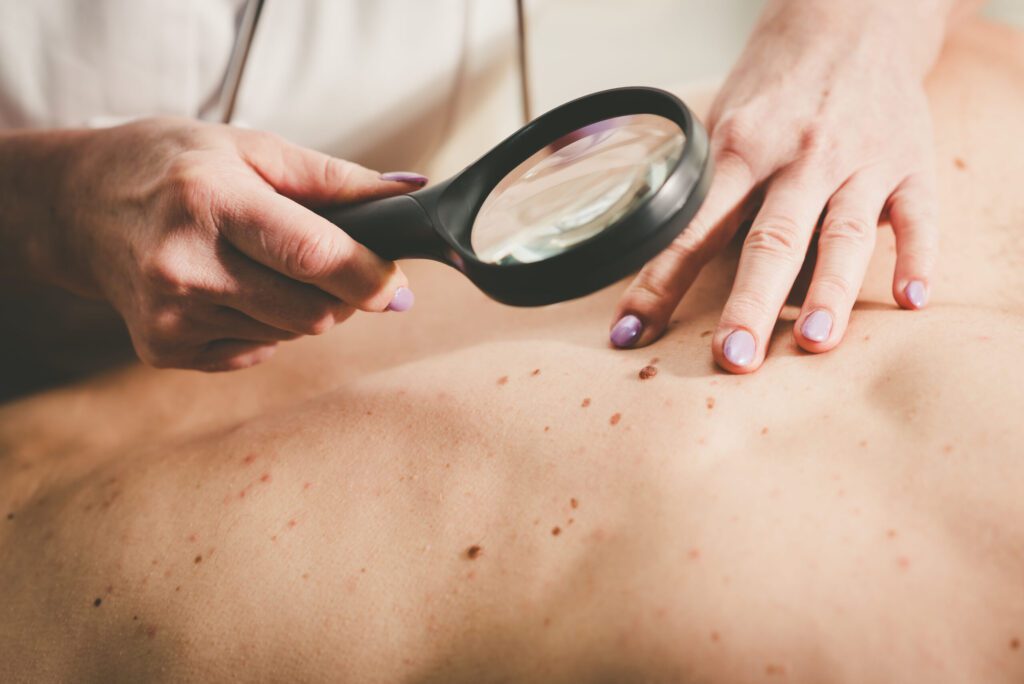Protection and Detection Are Key to Skin Cancer Treatment
by TERESA SCHIFFER
It’s summertime in Florida, and we don’t have to explain why we’re called “The Sunshine State.” However, it bears repeating that skin cancer is surprisingly common, and that damage from the sun’s ultraviolet radiation is cumulative over one’s lifetime – it doesn’t go away and let you start with a clean slate every summer.
We talked with local healthcare professionals for insight on how we can best protect ourselves from the damaging effects of sun exposure here in sunny Central Florida. Dr. Alex Kennon of Lakeside Dermatology in Winter Haven provides some sound advice on Florida fashions that provide protection.
“As we live in Florida, becoming a vampire is impractical,” Kennon jokes, “but limiting exposure to the sun is key to preventing skin cancer. Make sure when you are outside to seek a shaded area. Wear protective clothing with a UPF factor. A broad-brimmed hat and sunscreen are essential.”
When choosing a sunscreen, look for one that provides broad-spectrum protection with an SPF of at least 30. Apply sunscreen at least 15 minutes prior to heading outside, and then reapply at least every two hours. If you are sweating or in water at all, reapplication should be done every 40 minutes.
Kennon is a board-certified dermatologist who performed fellowship training in Mohs micrographic surgery. Mohs surgery is a very precise technique used primarily to remove lesions associated with skin cancer. This procedure allows the surgeon to remove cancerous tissue progressively, having it analyzed as the surgery proceeds, ultimately sparing nearly all surrounding unaffected tissue.
Mohs micrographic surgery is most effective as a treatment for the two most common types of skin cancer — basal cell carcinomas and squamous cell carcinomas. Basal cell carcinoma is thought to affect nearly 20 percent of the American population at some point in their lives.
“Basal cell carcinoma typically looks like a pearly, often ulcerated or bleeding bump that will not go away,” Kennon describes. “Squamous cell carcinoma often appears as a red scaly spot, or might even look like a volcano (a very specific type of squamous cell called a Keratoacanthoma).”
Although there are a number of less common skin cancers, malignant melanoma is widely recognized as the deadliest form of skin cancer, according to Dr. Toni Adams-Pecoraro. Adams-Pecoraro specializes in family medicine in Auburndale through BayCare Medical Group, with a strong focus on preventive health care.
“(Melanoma) is the most dangerous of the various skin cancers,” she explains. “It is the fifth-most-common cause of cancer in both women and men. Diagnosing melanoma early is very important in order to treat it quickly to avoid aggressive spreading.”
Kennon warns that skin cancer can affect any part of the body, “from the top of the scalp to the soles of the feet, and from the mouth to the genitalia. It is most common in areas that are chronically exposed to the sun, e.g. the face, ears, arms, and legs. Melanoma is more common on the backs of males and legs of females.”
Adams-Pecoraro warns that sometimes, melanoma can hide in areas that are more uncommon, such as the tissue of the mouth and nose, and on rare occasions under the nails.
In addition to sun exposure, other environmental factors can increase an individual’s risk of developing skin cancer, including exposure to ionizing radiation (such as that found in medical diagnostic tools like X-rays), exposure to arsenic or radon, and use of tanning beds. Smoking, some medications, chronic skin inflammation, and immunosuppression can also increase the risk of skin cancer.
Since not all skin cancers are a direct result of sun exposure, all demographics can be affected by the disease. However, individuals who have a fair skin complexion, red or blonde hair, blue or green eyes, or freckled skin have a higher risk of being affected by skin cancer. Other risk factors include advanced age, having more than 50 moles, a family or personal history of skin cancer, and skin that is easily burned by the sun.
Familiarizing yourself with the condition of your skin can help you notice symptoms of skin cancer early enough to receive effective treatment. Be on the lookout for areas of skin that appear pink or red, exhibit peeling, are thickened or rough, or inexplicably bleed. Melanoma may be indicated if a lesion appears asymmetrical or irregular in shape, is very large, or changes in size, color, or shape over time.
“To better detect possible skin cancer,” Adams-Pecoraro says, “checking your skin often for any new lesions or changes is important. You should also try to have a full-body skin check by your physician or dermatologist at least once a year.”
